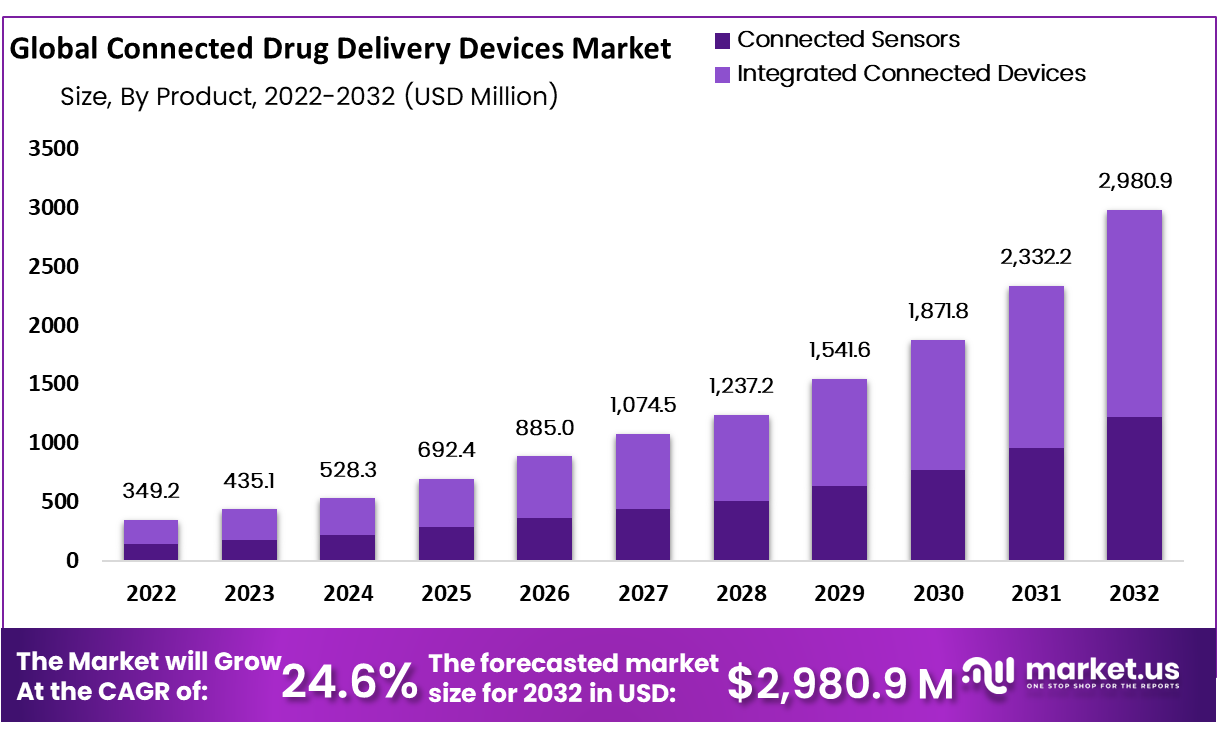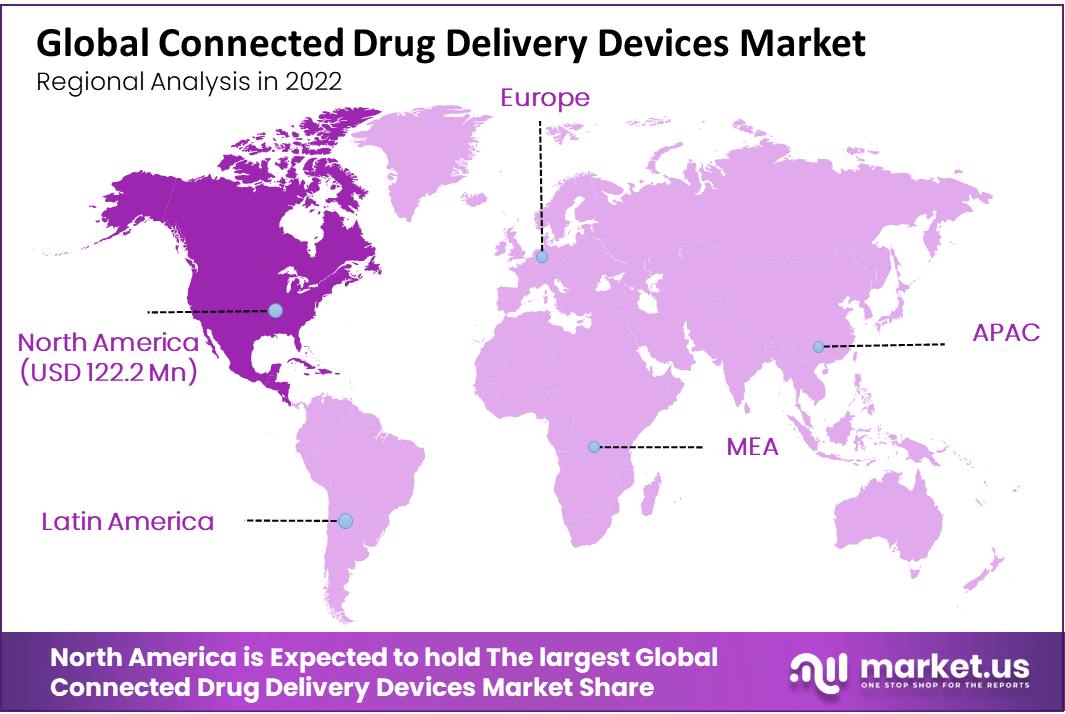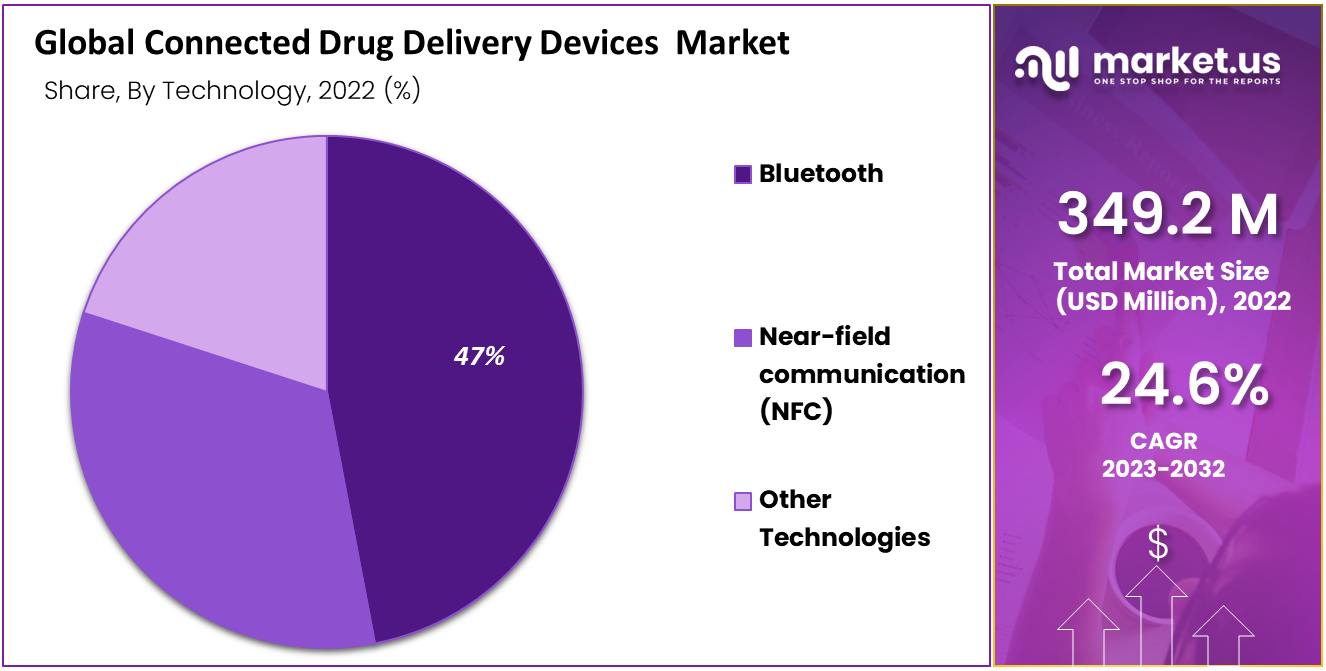New York, Oct. 09, 2023 (GLOBE NEWSWIRE) -- According to a recent report by Market.us, the Global Connected Drug Delivery Devices Market size is expected to be worth around USD 2,980.9 Million by 2032 from USD 349.2 Million in 2022, growing at a CAGR of 24.6 % during the forecast period from 2023 to 2032.
The connected drug delivery devices are the medical devices incorporating digital connectivity and communication capabilities that enable monitoring, tracking, and controlling the administration of medicine. In addition, these devices power the technology that improves treatment outcomes, enhances patient adherence, and provides healthcare professionals with precise data for personalized care. The growth of global connected drug delivery devices can be attributed to the increasing prevalence of chronic diseases, advancements in digital health technologies, and the need for personalized medicine.
Market.us has identified key trends, drivers, and challenges in the market, which will help clients improve their strategies to stay ahead of their competitors. - View a PDF sample report @ https://market.us/report/connected-drug-delivery-devices-market/request-sample/

Key Takeaway
- Connected dug delivery devices medical devices that utilize digital technologies to deliver effective medical care and efficient disease management.
- By Product, the integrated connected devices segment accounted for the highest revenue share in 2022.
- By Technology, the Bluetooth segment dominated the global market with the largest share of 47% in 2022.
- In case of application, diabetes segment held the largets market share, accounting for 31% of the revenue generated in 2022.
- On the basis of route of administration, injectable devices segments continues to be the most popular segment.
- By End-User, the home care segment is projected to dominate the global market during the forecast period.
- In 2022, North America dominated the market with the highest revenue share of 35%.
- Asia-Pacific will grow at a significant CAGR from 2023-2032.
Factors affecting the connected drug delivery devices market
There are several factors that can affect the growth of the global connected drug delivery devices market. Some of these factors include:
- Increase in healthcare expenditure: The market growth for connected drug delivery devices is mainly influenced by the increasing healthcare expenditure that provides financial support for implementing and adopting connected drug delivery devices.
- Rising Geriatric Population and Home Healthcare: The demand for home healthcare is increasing due to the adoption of connected drug delivery devices that offer convenience as well as ease of use for aged individuals opting to manage their conditions at home.
- Collaborations and partnerships: Several healthcare and technology firms collaborate to develop innovative connected drug delivery devices, driving market growth.
- Regulatory and compliance challenges: The market growth is likely to be hampered due to regulatory and compliance challenges. Obtaining regulatory approvals and meeting compliance standards can be costly and time-consuming, which poses a challenge for device manufacturers and delays their market entry.
Top Trends in Global Connected Drug Delivery Devices Market
Connecting drug delivery devices with wearable and implantable technologies has gained huge popularity. Implantable devices reduce the need for frequent administration, providing long-term medication delivery. Wearable devices like smartwatches can monitor vital signs, deliver personalized alerts, and track medication usage. Moreover, artificial intelligence and machine learning algorithms are increasingly being applied to connected drug delivery devices for analyzing large volumes of data. In addition, these technologies can help to personalize treatment plans, optimize dosing regimens, and predict patient response to medication. AI-powered devices adapt treatment strategies over time by learning from patients’ data.
Market Growth
The connected drug delivery devices offer the features such as real-time monitoring, dose tracking, reminders, and data sharing with healthcare providers, thereby improving medication adherence and patient engagement. As a result, it is expected to boost the market growth. However, the market growth of connected drug delivery devices is expected to be hampered by data privacy and security concerns.
Regional Analysis
North America dominated the global connected drug delivery devices market with a substantial market share of 35% in 2022. increasing preference for remote monitoring, the presence of the most prominent players, and the rapid adoption of technology drive the regional market growth exponentially. In addition, the regional growth can be attributed to the enhanced levels of per capita healthcare spending observed in the Asia Pacific. Alternatively, Asia Pacific is forecasted to expand at the highest CAGR as a result of the increasing number of players along with government initiatives. Moreover, the market growth of this region is also fueled by the availability of a huge patient population base.
To understand how our report can bring a difference to your business strategy, Inquire about a brochure at https://market.us/report/connected-drug-delivery-devices-market/#inquiry
Scope of the Report
| Report Attributes | Details |
| Market Value (2022) | USD 349.2 Million |
| Market Size in 2032 | USD 2,980.9 Million |
| CAGR (2023 to 2032) | 24.6% |
| North America Revenue Share | 35% |
| Historic Period | 2016 to 2021 |
| Base Year | 2022 |
| Forecast Year | 2023 to 2032 |
Market Drivers
The rapid advancements in technology, such as wireless connectivity, sensor technology, and miniaturization, have allowed the development of connected drug delivery devices that offer improved accuracy, enhanced patient engagement, and real-time monitoring, leading to better treatment outcomes. Furthermore, the growth of the global connected drug delivery devices market is mainly driven by the rising prevalence of chronic diseases such as asthma, diabetes, and cardiovascular diseases. This has created a need for convenient and effective drug delivery solutions. The connected drug delivery devices offer the features such as real-time monitoring, dose tracking, reminders, and data sharing with healthcare providers, thereby improving medication adherence and patient engagement thereby driving the market growth.
Market Restraints
Connected drug delivery devices produce and transfer sensitive patient data, such as treatment data and personal health information. Therefore, to gain the trust of patients, healthcare providers, and regulatory bodies, ensuring robust data privacy and security is crucial to taking certain measures. Any mishandling or breach of the patient’s sensitive data can challenge the adoption and acceptance of these devices, restricting market growth.
Market Opportunities
The connected drug delivery devices allow personalized medicine by providing real-time data on how the patient responds to the medication. This data helps healthcare providers optimize treatment plans, tailor the therapies to individual patients, and adjust dosages, leading to better treatment outcomes. Moreover, due to the improvement of healthcare infrastructure and better access to healthcare in emerging markets, there is a significant opportunity for the adoption of connected drug delivery devices. These devices enhance disease management in regions with limited healthcare resources.
Immediate Delivery Available | Buy This Premium Research Report @ https://market.us/purchase-report/?report_id=53276
Report Segmentation of the Connected Drug Delivery Devices Market
Product Insight
The Integrated connected devices segment dominated the global connected drug delivery devices market in 2022. These connected devices can provide patient reminders or alerts for medication schedules, allow real-time data tracking, and share data with healthcare providers. In addition, integrated drug delivery devices offer several benefits, including improved medication adherence, enhanced patient monitoring, and remote healthcare management. This drives the segment growth exponentially.
Technology Insight
The Bluetooth segment accounted for the highest revenue share of 47% in 2022. The Bluetooth-enabled devices can communicate with tablets, smartphones, and other healthcare systems, allowing for remote monitoring, seamless data transmission, and enhanced patient engagement. In addition, the segment growth is propelled by the technology that offers wireless connectivity and data transfer capabilities for drug delivery devices.
Application Insight
The connected drug delivery devices market is segmented into diabetes, respiratory, cardiovascular, anaphylaxis and other applications. Out of these segments, diabetes held the largest market share in 2022 which amounted to 31%. This can be attributed to the increasing incidence of diabetes. Further, te use of connected drug delivery devices can potentially revolutionize the treatment of diabetes. The cardiovascular segment is also growing at a rapid rate.
Route of Administration Insight
As far as route of administration is concerned, the injectable segment continues to dominate the market. The segment claims a large market share and is projected grow at an unmatched pace during the forecast period.
End-User Insight
The home care segment is projected to hold the largest revenue share during the forecast period. The connected drug delivery devices let the patients receive their treatment at home while being in contact with healthcare providers. As a result, this reduces the need for frequent hospital visits. Moreover, the rising adoption of connected drug delivery devices is a key driver behind the growth of this segment. In addition, the need to provide better patient experience and the rising prevalence of asthma and COPD are also anticipated to surge the market growth.
Recent Development of the Connected Drug Delivery Devices Market
- In February 2022, Aptar Pharma (global leader in drug delivery) systems introduced the HeroTracker Sense in the US, a new digital respiratory health solution transforming the (pMDI) into a smart connected healthcare device.
- In June 2023, Ypsomed announced colllaboation with S3 Cinnected Health to launch a platform for creating curated digital health solutions. This will enable effective chronic disease management with promising outcomes. The connected injection devices by Ypsomed will be integrated into the platform as well.
Market.us has identified key trends, drivers, and challenges in the market, which will help clients improve their strategies to stay ahead of their competitors. - View a PDF sample report @ https://market.us/report/connected-drug-delivery-devices-market/request-sample/

Market Segmentation
By Product
- Connected Sensors
- Integrated Connected Devices
By Technology
- Bluetooth
- Near-field communication (NFC)
- Other Technologies
By Application
- Respiratory
- Diabetes
- Cardiovascular
- Anaphylaxis
- Other Applications
By Route of Administration
- Injectable
- Inhalational
By End-User
- Hospitals
- Home Care
By Geography
- North America
- US
- Canada
- Europe
- Germany
- France
- The UK
- Spain
- Italy
- Russia
- Netherland
- Rest of Europe
- Asia Pacific
- China
- Japan
- South Korea
- India
- New Zealand
- Singapore
- Thailand
- Vietnam
- Rest of APAC
- Latin America
- Brazil
- Mexico
- Rest of Latin America
- Middle East & Africa
- South Africa
- Saudi Arabia
- UAE
- Rest of MEA
Competitive Landscape
Emerging key players in the global connected drug delivery devices market are now focused on implementing strategies such as partnerships, collaborations, mergers & acquisitions, new product launches, and competitive pricing. Medium to small companies are focused on precise solutions which cater to the market's customer requirements, e.g., software for connected devices, sensor manufacturing, etc. However, large companies are widely traded and have diverse portfolios with robust research & development, distribution, and sales capabilities.
Market Key Players
- Medtronic plc
- Johnson & Johnson Services Inc.
- Propeller Health (ResMed Inc.)
- BIOCORP
- Adherium Limited
- West Pharmaceutical Services Inc
- Becton Dickinson and Company
- Ypsomed AG
- Tandem Diabetes Care Inc.
- Other Key Players
Browse More Related Reports
- Hearing Aids Market size is expected to be worth around USD 13.2 billion by 2032 from USD 7.7 billion in 2022, growing at a CAGR of 5.7%
- Assisted Reproductive Technology Market accounted for USD 31.85 billion and is expected to reach around USD 179.4 billion in 2032
- Medical Devices Market size is expected to be worth around USD 656 Mn by 2032 from USD 492 Mn in 2022, growing at a CAGR of 3%
- Medical Device Outsourcing Market was valued at USD 116.7 Billion. This market is estimated to reach USD 352.3 Billion at the highest CAGR of 12.0%
- Smart Wearable, And Non-Wearable Devices Market size is expected to be worth around USD 105.8 Billion by 2032
- Smart Drug Delivery System Market was valued at USD 8.4 Billion, and from 2023 to 2032 it is expected to reach more than USD 32.5 Billion
- FemTech Market size is expected to be worth around USD 115.6 Billion by 2032 from USD 55.1 Billion in 2022
- Ophthalmic Knives Market size is expected to be worth around USD 530.3 Million by 2032 from USD 338.9 Million in 2022
- Implantable Cardioverter Defibrillator Market size is expected to be worth around USD 7.7 Billion by 2032 from USD 4.1 Billion in 2022
About Us:
Market.US (Powered by Prudour Pvt Ltd) specializes in in-depth market research and analysis and has been proving its mettle as a consulting and customized market research company, apart from being a much sought-after syndicated market research report-providing firm. Market.US provides customization to suit any specific or unique requirement and tailor-makes reports as per request. We go beyond boundaries to take analytics, analysis, study, and outlook to newer heights and broader horizons.
Follow Us on LinkedIn | Facebook | Twitter
Our Blog:
